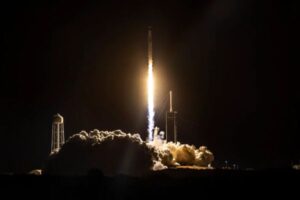Subtotal: 648,80€ (incl. VAT)
The space tourism we were promised is finally here—sort of
SpaceX weathered through the onset of the covid-19 pandemic last year to become the first private company to launch astronauts into space using a commercial spacecraft.
It’s poised to build on that success with another huge milestone before 2021 is over. On Monday, the company announced plans to launch the first “all-civilian” mission into orbit by the end of the year. Called Inspiration4, the mission will take billionaire Jared Isaacman, a trained pilot and the CEO of digital payments company Shift4Payments, plus three others into low Earth orbit via a Crew Dragon vehicle for two to four days, possibly longer.
Inspiration4 includes a charity element: Isaacman (the sole buyer of the mission and its “commander”) has donated $100 million to St. Jude Children’s Research Hospital, in Memphis, and is attempting to raise at least $100 million more from public donors. One seat is going to a “St. Jude ambassador” that’s already been chosen. But the two others are still up for grabs: one will be raffled off to someone who donates at least $10 to St. Jude, while the other will be a business entrepreneur chosen through a competition held by Shift4Payments.
“This is an important milestone towards enabling access to space for everyone,” SpaceX CEO Elon Musk told reporters on Monday. “It is only through missions like this that we’re able to bring the cost down over time and make space accessible to all.”
Inspiration4 marks SpaceX’s fourth scheduled private mission in the next few years. The other three include a collaboration with Axiom Space to use Crew Dragon to take four people for an eight-day stay aboard the International Space Station (now scheduled for no earlier than January 2022); another Crew Dragon mission into orbit later that year for four private citizens through tourism company Space Adventures; and Japanese billionaire Yusaku Maezawa’s #dearMoon mission around the moon in 2023 for himself plus seven to 10 others aboard the Starship spacecraft.
SpaceX has never really billed itself as a space tourism company as aggressively as Blue Origin and Virgin Galactic have. While Crew Dragon goes all the way into low-Earth orbit, Virgin Galactic’s SpaceShipTwo and Blue Origin’s New Shepard vehicles just go into suborbital space, offering a taste of microgravity and a view of the Earth from high above for just a few minutes—but for way less money. And yet, in building a business that goes even farther, with higher launch costs and the need for more powerful rockets, SpaceX already has four more private missions on the books than any other company does.
When Crew Dragon first took NASA astronauts into space last year, one of the biggest questions to come up was whether customers outside NASA would actually be interested in going.
“A lot of people believe there is a market for space tourism,” says Howard McCurdy, a space policy expert at American University in Washington, DC. “But right now it’s at the very high end. As transportation capabilities improve, the hope is that the costs will come down. That begs the question of whether or not you can sustain a new space company on space tourism alone. I think that’s questionable.”
So why has SpaceX’s expansion into the private mission scene gone so well so far? Part of it must be that it’s such an attractive brand to partner with at the moment. But even if a market does not materialize soon to make private missions a profitable venture, SpaceX doesn’t need to be concerned. It has plenty of other ways to make money.
“I’m not sure Elon Musk cares much if he makes money through this business,” says McCurdy. “But he’s very good at leveraging and financing his operations.” SpaceX launches satellites for government and commercial customers around the world; it’s got contracts with NASA for taking cargo and astronauts alike to the space station; it’s ramping up progress with building out the Starlink constellation and should start offering internet services to customers some time this year.
“It really reduces your risk when you can have multiple sources of revenue and business for an undertaking that’s based upon the single leap of rockets and space technologies,” says McCurdy. “The market for space tourism is not large enough to sustain a commercial space company. When combined with government contracts, private investments, and foreign sales it starts to become sustainable.”
Space tourism, especially to low-Earth orbit, will still remain incredibly expensive for the foreseeable future. And that underscores the issue of equity. “If we’re going into space, who’s the ‘we’?” asks McCurdy. “Is it just the top 1% of the top 1%?”
The lottery concept addresses this to some extent and offers opportunities to ordinary people, but it won’t be enough on its own. Space tourism, and the rest of the space industry, still needs a sustainable model that can invite more people to participate.
For now, SpaceX appears to be leading the drive to popularize space tourism. And competitors don’t necessarily need to emulate SpaceX’s business model precisely in order to catch up. Robert Goehlich, a German-based space tourism expert at Embry-Riddle Aeronautical University, notes that space tourism itself is already multifaceted, encompassing suborbital flights, orbital flights, space station flights, space hotel flights, and moon flights. The market for one, such as cheaper suborbital flights, is not necessarily faced with the same constraints as the others.
Still, there is no question this could be the year private missions become a reality. “We’ve waited a long time for space tourism,” says McCurdy. “We’re going to get a chance this year to see if it works as expected.”



